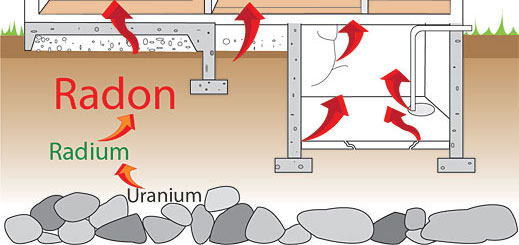Do I Need to Test My Home for Radon?
In 2005, the US Surgeon General issued the following health advisory: “Indoor radon is the second-leading cause of lung cancer in the United States and breathing it over prolonged periods can present a significant health risk to families all over the country. It’s important to know that this threat is completely preventable. Radon can be detected with a simple test and fixed through well-established venting techniques.”

Fifteen counties located in north and central Alabama have been identified with high potential for radon gas. The Alabama Cooperative Extension agency has a radon education and testing program to help residents identify and minimize health risks from exposure to radon in the home, according to Patricia Smith, the Alabama State Radon Coordinator for the agency.
Radon is an odorless radioactive soil gas commonly found in areas with lots of granite, shale, phosphate and pitchblende. When homes are built on soils emitting radon gas the structures can trap the gas inside the home and place occupants at risk for lung cancer from breathing indoor air with elevated levels of radon. Radon gas has been identified as the second leading cause of lung cancer after smoking.
Ms. Smith was on hand at the Fall Home and Garden Show last week in Huntsville to offer an easy, low-cost way to test a home for elevated radon levels. Testing requires sampling indoor air by placing the small container inside the living space according to the test kit instructions. The test sample is mailed to a lab for analysis and results are returned directly to the participant. Josh Mills purchased one to test his home in Harvest saying, “For seven bucks, it’s worth it”.
Colbert County has the biggest problem with elevated radon levels in 35% of tested homes, followed by Madison and Cleburne County where 31% of tested homes have elevated radon levels.
Radon tests of homes in thirteen other counties with high radon risk yielded the following rates of elevated indoor radon levels:
- Lauderdale (25%)
- Coosa (22%)
- Franklin (20%)
- Jackson (18%)
- Calhoun (17%)
- Lawrence (13%)
- Talladega (13%)
- Clay (13%)
- Morgan (13%)
- Limestone (12%)
- Shelby (11%)
- Jefferson (10%)
Elevated radon inside the home varies widely and neighboring homes can have vastly different levels, so every home in high-risk counties should be tested. Test kits and instructions for evaluating your home can purchased three ways – in person at Alabama Cooperative Extension offices, by calling the Alabama Radon Hotline at 800-582-1866, or online at www.aces.edu/radon.

Patricia Smith instructs Josh Mills of Harvest, Alabama on how to use the home radon test kit.
Radon problems are easy to fix or guard against. The cost of repairs averages $1,800 nationwide and usually involves isolating the soil under the home. New homes in areas at risk for radon should be built with radon-resistant features at minimal added cost, often less than $500. Most green building standards, such as LEED, require radon resistant construction features.
Radon prevention, energy savings and building durability are key drivers for crawl space encapsulation, a process that usually moves a home’s thermal boundary and air barrier from the floor framing out to the foundation walls and includes an air and vapor seal over the soil on the bottom of the crawl space. This will seal out all soil gases, including radon and moisture issues to improve indoor air quality and comfort. Several AlabamaWISE contractors offer encapsulation as part of a home performance and energy efficiency improvement.
More information about radon is available from the Environmental Protection Agency at http://www.epa.gov/radon/pubs/citguide.html
Radon graphic by Kathleen Ochmanski from the Periodic Table Printmaking Project http://www.periodictableprints.com/table/


Comments are closed.